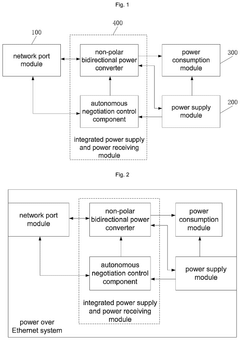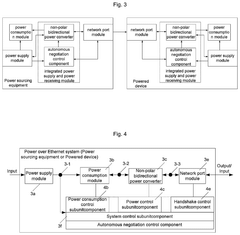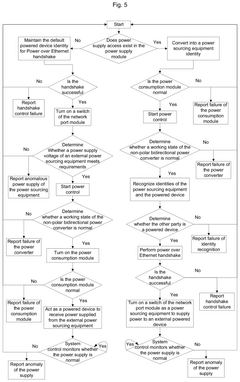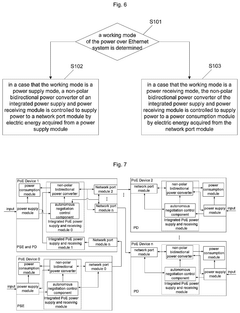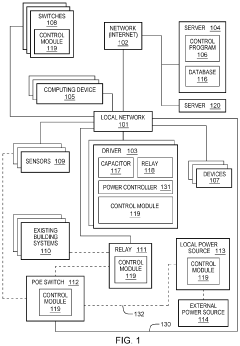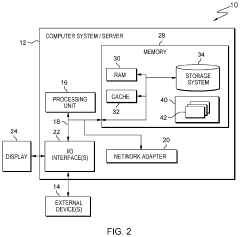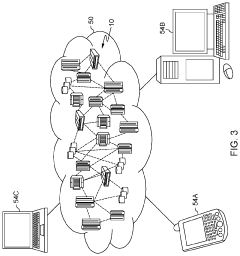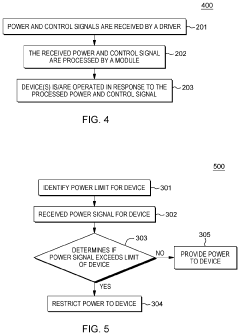How To Apply PoE++ In Intelligent Transportation Systems
SEP 24, 20259 MIN READ
Generate Your Research Report Instantly with AI Agent
Patsnap Eureka helps you evaluate technical feasibility & market potential.
PoE++ Technology Background and Objectives
Power over Ethernet Plus Plus (PoE++) technology has evolved significantly since the introduction of the original PoE standard in 2003. The IEEE 802.3bt standard, commonly known as PoE++, represents the third generation of this technology, enabling power delivery up to 90W per port compared to the 15.4W of the original standard. This substantial increase in power capacity has opened new possibilities for applications in various domains, particularly in Intelligent Transportation Systems (ITS) where power requirements are diverse and demanding.
The evolution of PoE technology reflects the growing need for integrated power and data solutions in networked environments. From the initial IEEE 802.3af standard (PoE) to IEEE 802.3at (PoE+) and now IEEE 802.3bt (PoE++), each iteration has expanded capabilities while maintaining backward compatibility, ensuring a smooth transition path for existing infrastructure.
In the context of Intelligent Transportation Systems, PoE++ addresses critical challenges related to power distribution, installation complexity, and system reliability. Traditional ITS deployments often require separate power and data infrastructures, leading to increased costs, maintenance challenges, and potential points of failure. The convergence of power and data transmission over a single Ethernet cable presents a compelling solution to these longstanding issues.
The primary technical objective for PoE++ application in ITS is to establish a unified, scalable infrastructure that can support the diverse array of devices required in modern transportation networks. These include high-definition cameras, environmental sensors, traffic controllers, digital signage, wireless access points, and emerging edge computing devices that process data locally to reduce latency in time-critical applications.
Another key objective is enhancing system resilience through simplified architecture. By reducing the number of components and connection points, PoE++ implementations can potentially improve mean time between failures (MTBF) metrics for ITS deployments. This is particularly valuable in transportation environments where maintenance access may be challenging and system downtime carries significant safety and operational implications.
Energy efficiency represents a further technical goal, with PoE++ offering intelligent power management capabilities. The standard includes features for dynamic power allocation, allowing devices to draw only the power they need at any given moment. This capability aligns with sustainability initiatives increasingly prioritized in transportation infrastructure projects worldwide.
Looking forward, the technology trajectory for PoE++ in ITS applications points toward even greater integration with emerging standards such as Time-Sensitive Networking (TSN) and Software-Defined Networking (SDN). These complementary technologies can enhance the deterministic performance characteristics essential for safety-critical ITS applications while providing the flexibility needed to adapt to evolving transportation challenges.
The evolution of PoE technology reflects the growing need for integrated power and data solutions in networked environments. From the initial IEEE 802.3af standard (PoE) to IEEE 802.3at (PoE+) and now IEEE 802.3bt (PoE++), each iteration has expanded capabilities while maintaining backward compatibility, ensuring a smooth transition path for existing infrastructure.
In the context of Intelligent Transportation Systems, PoE++ addresses critical challenges related to power distribution, installation complexity, and system reliability. Traditional ITS deployments often require separate power and data infrastructures, leading to increased costs, maintenance challenges, and potential points of failure. The convergence of power and data transmission over a single Ethernet cable presents a compelling solution to these longstanding issues.
The primary technical objective for PoE++ application in ITS is to establish a unified, scalable infrastructure that can support the diverse array of devices required in modern transportation networks. These include high-definition cameras, environmental sensors, traffic controllers, digital signage, wireless access points, and emerging edge computing devices that process data locally to reduce latency in time-critical applications.
Another key objective is enhancing system resilience through simplified architecture. By reducing the number of components and connection points, PoE++ implementations can potentially improve mean time between failures (MTBF) metrics for ITS deployments. This is particularly valuable in transportation environments where maintenance access may be challenging and system downtime carries significant safety and operational implications.
Energy efficiency represents a further technical goal, with PoE++ offering intelligent power management capabilities. The standard includes features for dynamic power allocation, allowing devices to draw only the power they need at any given moment. This capability aligns with sustainability initiatives increasingly prioritized in transportation infrastructure projects worldwide.
Looking forward, the technology trajectory for PoE++ in ITS applications points toward even greater integration with emerging standards such as Time-Sensitive Networking (TSN) and Software-Defined Networking (SDN). These complementary technologies can enhance the deterministic performance characteristics essential for safety-critical ITS applications while providing the flexibility needed to adapt to evolving transportation challenges.
Market Demand Analysis for PoE++ in ITS
The global market for Power over Ethernet (PoE++) in Intelligent Transportation Systems (ITS) is experiencing robust growth, driven by increasing urbanization and the need for smarter, more efficient transportation infrastructure. Current market projections indicate that the global ITS market is expected to reach $39.5 billion by 2026, with PoE-enabled devices constituting a significant portion of this growth. The compound annual growth rate (CAGR) for PoE technology in transportation applications specifically is estimated at 12.8% through 2028, outpacing many other technological segments in the transportation sector.
The demand for PoE++ in ITS stems primarily from four key market drivers. First, the proliferation of connected devices in transportation infrastructure has created a need for simplified power and data solutions. Traffic cameras, sensors, digital signage, and communication gateways all require reliable power and network connectivity, which PoE++ efficiently provides through a single cable.
Second, government initiatives worldwide are accelerating ITS adoption. The European Union's Intelligent Transport Systems Directive, the United States' Smart City Challenge, and China's New Infrastructure Plan all emphasize the development of intelligent transportation networks, creating substantial market opportunities for PoE++ technology implementation.
Third, operational cost reduction has become a critical factor for transportation authorities. PoE++ systems demonstrate 30-40% lower installation costs compared to traditional power systems due to reduced cabling requirements and simplified infrastructure. Additionally, centralized power management enables more efficient energy consumption, with studies showing potential energy savings of 15-20% in large-scale deployments.
Fourth, the increasing focus on sustainability in transportation is driving demand for more energy-efficient solutions. PoE++ systems with advanced power management capabilities allow for dynamic power allocation based on actual needs, reducing overall energy consumption in transportation networks.
Market segmentation analysis reveals that traffic management applications currently represent the largest market share for PoE++ in ITS at approximately 42%, followed by public transportation systems (27%), parking management (18%), and emergency services (13%). Geographically, North America leads adoption with 38% market share, followed by Europe (31%), Asia-Pacific (24%), and rest of the world (7%).
Customer needs assessment indicates that transportation authorities and system integrators prioritize scalability, reliability, and interoperability when selecting PoE++ solutions. The ability to support future expansion, maintain operation during adverse conditions, and integrate with existing systems are considered critical purchasing factors by over 80% of decision-makers in the sector.
The demand for PoE++ in ITS stems primarily from four key market drivers. First, the proliferation of connected devices in transportation infrastructure has created a need for simplified power and data solutions. Traffic cameras, sensors, digital signage, and communication gateways all require reliable power and network connectivity, which PoE++ efficiently provides through a single cable.
Second, government initiatives worldwide are accelerating ITS adoption. The European Union's Intelligent Transport Systems Directive, the United States' Smart City Challenge, and China's New Infrastructure Plan all emphasize the development of intelligent transportation networks, creating substantial market opportunities for PoE++ technology implementation.
Third, operational cost reduction has become a critical factor for transportation authorities. PoE++ systems demonstrate 30-40% lower installation costs compared to traditional power systems due to reduced cabling requirements and simplified infrastructure. Additionally, centralized power management enables more efficient energy consumption, with studies showing potential energy savings of 15-20% in large-scale deployments.
Fourth, the increasing focus on sustainability in transportation is driving demand for more energy-efficient solutions. PoE++ systems with advanced power management capabilities allow for dynamic power allocation based on actual needs, reducing overall energy consumption in transportation networks.
Market segmentation analysis reveals that traffic management applications currently represent the largest market share for PoE++ in ITS at approximately 42%, followed by public transportation systems (27%), parking management (18%), and emergency services (13%). Geographically, North America leads adoption with 38% market share, followed by Europe (31%), Asia-Pacific (24%), and rest of the world (7%).
Customer needs assessment indicates that transportation authorities and system integrators prioritize scalability, reliability, and interoperability when selecting PoE++ solutions. The ability to support future expansion, maintain operation during adverse conditions, and integrate with existing systems are considered critical purchasing factors by over 80% of decision-makers in the sector.
Technical Status and Challenges of PoE++ in Transportation
Power over Ethernet Plus Plus (PoE++) technology has evolved significantly in recent years, with the IEEE 802.3bt standard (2018) marking a major advancement by enabling up to 90W power delivery over standard Ethernet cables. In transportation systems, this technology has seen limited but growing implementation, primarily in traffic management systems, surveillance cameras, and digital signage. The current adoption rate remains relatively low compared to other sectors like enterprise networking and building automation.
The global landscape of PoE++ in transportation shows uneven development. North America and Europe lead in implementation, particularly in smart city initiatives where intelligent transportation systems (ITS) are prioritized. Asian markets, especially China and South Korea, are rapidly advancing their PoE++ deployments in newly constructed transportation infrastructure. Developing regions face significant adoption barriers due to the higher initial investment requirements and existing legacy systems.
Technical challenges for PoE++ in transportation environments are substantial. The harsh outdoor conditions present in transportation settings—including extreme temperatures (-40°C to +75°C), moisture, vibration, and electromagnetic interference from vehicles—demand ruggedized equipment that exceeds standard commercial specifications. This necessitates specialized engineering solutions and increases implementation costs.
Power management represents another critical challenge. While 90W is sufficient for many ITS devices, more power-hungry applications like high-definition PTZ cameras with heating elements, advanced roadside computing units, and multiple-display information systems often operate at the upper limits of PoE++ capacity. This creates reliability concerns during peak demand periods and limits scalability.
Network infrastructure compatibility issues further complicate deployment. Many existing transportation networks utilize older cabling (Cat5e or below) that cannot reliably support PoE++ power levels without overheating or voltage drop over long distances. The typical distances in transportation applications (often exceeding 100 meters) create additional challenges for maintaining power integrity.
Standardization and interoperability remain problematic. Despite the IEEE standard, vendor-specific implementations sometimes create compatibility issues between power sourcing equipment (PSE) and powered devices (PD). This fragmentation complicates system integration and maintenance, particularly in transportation networks that typically incorporate equipment from multiple vendors and generations.
Security vulnerabilities present an emerging concern. As PoE++ systems become more prevalent in critical transportation infrastructure, they face increased risk from both physical tampering and network-based attacks that could potentially disrupt power delivery to essential systems. The dual nature of PoE++ as both a power and data delivery mechanism creates unique security challenges that traditional network security approaches may not fully address.
The global landscape of PoE++ in transportation shows uneven development. North America and Europe lead in implementation, particularly in smart city initiatives where intelligent transportation systems (ITS) are prioritized. Asian markets, especially China and South Korea, are rapidly advancing their PoE++ deployments in newly constructed transportation infrastructure. Developing regions face significant adoption barriers due to the higher initial investment requirements and existing legacy systems.
Technical challenges for PoE++ in transportation environments are substantial. The harsh outdoor conditions present in transportation settings—including extreme temperatures (-40°C to +75°C), moisture, vibration, and electromagnetic interference from vehicles—demand ruggedized equipment that exceeds standard commercial specifications. This necessitates specialized engineering solutions and increases implementation costs.
Power management represents another critical challenge. While 90W is sufficient for many ITS devices, more power-hungry applications like high-definition PTZ cameras with heating elements, advanced roadside computing units, and multiple-display information systems often operate at the upper limits of PoE++ capacity. This creates reliability concerns during peak demand periods and limits scalability.
Network infrastructure compatibility issues further complicate deployment. Many existing transportation networks utilize older cabling (Cat5e or below) that cannot reliably support PoE++ power levels without overheating or voltage drop over long distances. The typical distances in transportation applications (often exceeding 100 meters) create additional challenges for maintaining power integrity.
Standardization and interoperability remain problematic. Despite the IEEE standard, vendor-specific implementations sometimes create compatibility issues between power sourcing equipment (PSE) and powered devices (PD). This fragmentation complicates system integration and maintenance, particularly in transportation networks that typically incorporate equipment from multiple vendors and generations.
Security vulnerabilities present an emerging concern. As PoE++ systems become more prevalent in critical transportation infrastructure, they face increased risk from both physical tampering and network-based attacks that could potentially disrupt power delivery to essential systems. The dual nature of PoE++ as both a power and data delivery mechanism creates unique security challenges that traditional network security approaches may not fully address.
Current PoE++ Implementation Solutions for ITS
01 Power delivery capabilities of PoE++
PoE++ (IEEE 802.3bt) significantly increases power delivery capabilities over previous PoE standards, allowing for up to 90-100W of power to be transmitted over Ethernet cables. This enhanced power capacity enables the technology to support more power-hungry devices such as high-performance wireless access points, pan-tilt-zoom cameras, digital signage displays, and even desktop computers. The standard achieves this by utilizing all four pairs of wires in an Ethernet cable for power transmission, compared to earlier standards that used only two pairs.- Power delivery capabilities of PoE++ technology: PoE++ (IEEE 802.3bt) significantly increases power delivery capabilities over previous PoE standards, allowing for up to 90-100W of power to be transmitted over Ethernet cables. This enhanced power delivery enables the technology to support more power-hungry devices such as high-performance wireless access points, pan-tilt-zoom cameras, digital signage displays, and thin clients. The increased power capacity is achieved through utilizing all four pairs of wires in an Ethernet cable for power transmission, compared to earlier standards that used only two pairs.
- Power management and negotiation protocols: PoE++ implements sophisticated power management and negotiation protocols to ensure efficient and safe power delivery. These protocols include enhanced classification mechanisms that allow powered devices (PDs) to communicate their power requirements to power sourcing equipment (PSE). The system supports dynamic power allocation, where devices can request different power levels based on their operational needs, and includes safeguards to prevent power overloads. Advanced handshaking between PSE and PD ensures compatibility and proper power delivery, reducing the risk of damage to connected equipment.
- Network architecture and integration solutions: PoE++ technology offers various network architecture and integration solutions that enable seamless deployment in existing infrastructures. These solutions include specialized PoE++ switches, injectors, and splitters that can be integrated into different network topologies. The technology supports both centralized and distributed power architectures, allowing for flexible deployment options. Integration with network management systems enables remote monitoring and control of powered devices, facilitating easier maintenance and troubleshooting of PoE++ networks.
- Thermal management and efficiency improvements: PoE++ systems incorporate advanced thermal management techniques and efficiency improvements to handle the increased power levels. These include enhanced heat dissipation methods in both power sourcing equipment and powered devices, more efficient power conversion circuits that reduce energy loss, and intelligent power management algorithms that optimize power usage based on actual needs. The technology also implements improved cable specifications and connector designs to handle higher current levels while maintaining safety and reliability.
- Application-specific implementations and use cases: PoE++ technology enables various application-specific implementations across different industries. These include specialized solutions for smart building systems, industrial automation, healthcare facilities, and retail environments. The technology supports advanced IoT deployments by providing both data connectivity and sufficient power for edge computing devices. Specific implementations include integrated lighting systems, building automation controllers, advanced security systems with facial recognition capabilities, and digital signage with interactive features, all powered and connected through a single Ethernet cable.
02 Power management and negotiation protocols
PoE++ implements advanced power management and negotiation protocols that enable more efficient power allocation and usage. These protocols allow powered devices (PDs) to communicate their specific power requirements to power sourcing equipment (PSE), facilitating dynamic power allocation based on actual needs rather than fixed allocations. This includes features such as power class discovery, fine-grained power negotiation, and support for different power classes that help optimize power distribution across multiple connected devices while preventing overloading of the power supply system.Expand Specific Solutions03 Network architecture and integration solutions
PoE++ technology can be integrated into various network architectures to provide both data connectivity and power through a single cable infrastructure. This integration includes specialized network switches with built-in PoE++ capabilities, midspan injectors that can add PoE++ functionality to existing networks, and endpoint devices designed to receive both power and data through the same connection. These solutions enable simplified installation, reduced cabling requirements, and more flexible deployment options for powered devices throughout a network environment.Expand Specific Solutions04 Thermal management and safety features
Due to the higher power levels involved, PoE++ systems incorporate advanced thermal management and safety features to prevent overheating and ensure reliable operation. These include temperature monitoring circuits, automatic power reduction mechanisms when thermal thresholds are exceeded, short-circuit protection, and electrical isolation between power and data lines. These safety features help protect both the power sourcing equipment and powered devices from damage while maintaining network reliability and preventing fire hazards associated with higher power transmission.Expand Specific Solutions05 Energy efficiency and smart power control
PoE++ implementations often include energy efficiency features and smart power control mechanisms to optimize power consumption. These include sleep modes for powered devices during periods of inactivity, gradual power-up sequences to prevent inrush current issues, load shedding capabilities during power constraints, and power scheduling based on time-of-day or usage patterns. These features help reduce overall energy consumption, lower operational costs, and support green initiatives while maintaining the functionality and availability of powered devices when needed.Expand Specific Solutions
Key Industry Players in PoE++ and ITS Integration
The Power over Ethernet Plus Plus (PoE++) technology in Intelligent Transportation Systems (ITS) is currently in a growth phase, with the market expected to expand significantly as smart city initiatives accelerate globally. The market size for PoE++ in ITS applications is projected to reach several billion dollars by 2025, driven by increasing demand for connected traffic management systems and smart infrastructure. Technologically, industry leaders like Cisco Systems, Huawei, and HPE have achieved considerable maturity in developing PoE++ solutions that deliver higher power capabilities essential for ITS applications. Companies including Robert Bosch, Hikvision, and Baidu are advancing specialized ITS implementations, while networking specialists such as ZTE, Ruijie Networks, and Sangfor Technologies are enhancing the connectivity infrastructure required for comprehensive transportation systems integration.
Cisco Technology, Inc.
Technical Solution: Cisco has developed a comprehensive PoE++ solution for Intelligent Transportation Systems (ITS) that leverages their Universal Power Over Ethernet (UPOE+) technology, delivering up to 90W per port across all ports simultaneously. Their approach integrates with their Digital Network Architecture (DNA) to create a connected transportation infrastructure where traffic signals, roadside cameras, environmental sensors, and digital signage can all be powered and networked through a single Ethernet cable. Cisco's ITS implementation includes specialized ruggedized switches like the IE-4000 series that can withstand extreme temperatures (-40°C to +75°C) and harsh roadside environments while providing reliable PoE++ power. Their solution incorporates advanced power management features that allow for dynamic power allocation based on device needs and priorities, ensuring critical traffic management systems remain operational even during power constraints.
Strengths: Industry-leading power delivery capabilities (up to 90W), extensive ecosystem integration, robust security features, and proven reliability in harsh environments. Weaknesses: Higher cost compared to competitors, proprietary elements in their ecosystem may limit interoperability with third-party devices.
Huawei Technologies Co., Ltd.
Technical Solution: Huawei has engineered a sophisticated PoE++ solution for intelligent transportation applications centered around their eSight network management platform. Their technology delivers up to 60W of power per port on their S5700 and S6700 series switches, enabling the deployment of high-power ITS devices such as HD traffic monitoring cameras with pan-tilt-zoom capabilities, roadside computing units, and environmental monitoring stations. Huawei's approach emphasizes intelligent power management with features like PD (Powered Device) priority settings, scheduled power supply, and real-time power consumption monitoring. Their solution incorporates AI-driven analytics to optimize power distribution based on traffic patterns and environmental conditions, automatically adjusting power allocation during peak hours or adverse weather. Huawei has implemented this technology in several smart city projects, particularly in Asia, where their PoE++ infrastructure supports traffic flow optimization systems that have reportedly reduced congestion by up to 15% in pilot deployments.
Strengths: Strong integration with AI and cloud platforms, comprehensive power management features, and extensive deployment experience in smart city projects. Weaknesses: Geopolitical concerns may limit adoption in certain markets, and some advanced features require full commitment to Huawei's ecosystem.
Core Technical Innovations in PoE++ for Transportation
Power over Ethernet System, Related Method and Related Apparatus
PatentPendingUS20250150293A1
Innovation
- The proposed PoE system incorporates an integrated power supply and power receiving module with a non-polar bidirectional power converter and an autonomous negotiation control component, allowing the system to function as both a PSE and a PD, reducing the need for multiple devices and optimizing space usage.
Method and system for managing power delivery and device operation over a meshed power over ethernet network
PatentActiveUS20240031179A1
Innovation
- A mesh PoE system that utilizes a wireless mesh network with a cloud-based management system, eliminating the need for physical connections and allowing devices to act as gateways, thereby increasing the number of devices that can be integrated and the area covered, while reducing energy consumption and enhancing versatility.
Standardization and Compliance Requirements
The implementation of Power over Ethernet Plus Plus (PoE++) in Intelligent Transportation Systems (ITS) necessitates adherence to rigorous standardization and compliance requirements to ensure interoperability, safety, and reliability. The IEEE 802.3bt standard, also known as PoE++, provides the foundation for these requirements, enabling power delivery up to 90W through Ethernet cables. This standard must be strictly followed when deploying PoE++ solutions in transportation infrastructure.
Transportation systems are subject to specific regulatory frameworks that vary by region. In the United States, ITS implementations must comply with the National Transportation Communications for ITS Protocol (NTCIP), which ensures compatibility between different transportation devices and systems. Similarly, the European Telecommunications Standards Institute (ETSI) provides standards for intelligent transport in Europe. Any PoE++ deployment must align with these regional transportation protocols while maintaining compliance with the IEEE electrical standards.
Environmental compliance represents another critical dimension for PoE++ in transportation applications. Outdoor ITS equipment powered by PoE++ must meet IP67 or IP66 ratings for water and dust resistance. Temperature tolerance specifications are equally important, with requirements typically ranging from -40°C to +75°C for roadside equipment. These environmental standards ensure the longevity and reliability of PoE++ powered devices in harsh outdoor conditions.
Safety certifications constitute a non-negotiable aspect of PoE++ implementation in transportation systems. UL certification in North America and CE marking in Europe verify that the equipment meets essential safety requirements. Additionally, transportation-specific safety standards such as NEMA TS2 for traffic control equipment must be satisfied. These certifications address concerns related to electrical safety, fire resistance, and operational reliability under various conditions.
Electromagnetic compatibility (EMC) standards are particularly relevant for PoE++ applications in ITS due to the potential for interference with critical communication systems. Compliance with standards like IEC 61000 ensures that PoE++ powered devices neither generate harmful electromagnetic interference nor are susceptible to external electromagnetic disturbances. This is crucial for maintaining the integrity of traffic management systems and emergency communications.
Cybersecurity compliance has emerged as an increasingly important requirement for connected transportation systems. PoE++ implementations must adhere to frameworks such as NIST Cybersecurity Framework and IEC 62443 for industrial control systems. These standards help protect transportation infrastructure from cyber threats by establishing requirements for secure communication, access control, and vulnerability management in networked PoE++ devices.
Transportation systems are subject to specific regulatory frameworks that vary by region. In the United States, ITS implementations must comply with the National Transportation Communications for ITS Protocol (NTCIP), which ensures compatibility between different transportation devices and systems. Similarly, the European Telecommunications Standards Institute (ETSI) provides standards for intelligent transport in Europe. Any PoE++ deployment must align with these regional transportation protocols while maintaining compliance with the IEEE electrical standards.
Environmental compliance represents another critical dimension for PoE++ in transportation applications. Outdoor ITS equipment powered by PoE++ must meet IP67 or IP66 ratings for water and dust resistance. Temperature tolerance specifications are equally important, with requirements typically ranging from -40°C to +75°C for roadside equipment. These environmental standards ensure the longevity and reliability of PoE++ powered devices in harsh outdoor conditions.
Safety certifications constitute a non-negotiable aspect of PoE++ implementation in transportation systems. UL certification in North America and CE marking in Europe verify that the equipment meets essential safety requirements. Additionally, transportation-specific safety standards such as NEMA TS2 for traffic control equipment must be satisfied. These certifications address concerns related to electrical safety, fire resistance, and operational reliability under various conditions.
Electromagnetic compatibility (EMC) standards are particularly relevant for PoE++ applications in ITS due to the potential for interference with critical communication systems. Compliance with standards like IEC 61000 ensures that PoE++ powered devices neither generate harmful electromagnetic interference nor are susceptible to external electromagnetic disturbances. This is crucial for maintaining the integrity of traffic management systems and emergency communications.
Cybersecurity compliance has emerged as an increasingly important requirement for connected transportation systems. PoE++ implementations must adhere to frameworks such as NIST Cybersecurity Framework and IEC 62443 for industrial control systems. These standards help protect transportation infrastructure from cyber threats by establishing requirements for secure communication, access control, and vulnerability management in networked PoE++ devices.
Energy Efficiency and Sustainability Considerations
The integration of Power over Ethernet Plus Plus (PoE++) in Intelligent Transportation Systems (ITS) presents significant opportunities for enhancing energy efficiency and sustainability across transportation networks. PoE++ technology, with its capability to deliver up to 90W of power through standard Ethernet cables, enables more efficient power distribution to various ITS components while reducing the overall environmental footprint of transportation infrastructure.
Energy consumption in traditional transportation systems often involves multiple power conversion stages, resulting in substantial energy losses. PoE++ minimizes these losses by utilizing direct current (DC) power distribution, eliminating the need for AC-to-DC conversion at each device. This efficiency gain translates to approximately 15-20% reduction in energy consumption compared to conventional power distribution methods used in transportation systems.
The centralized power management capabilities of PoE++ further enhance energy conservation through intelligent power allocation. During off-peak hours or low traffic periods, the system can automatically reduce power to non-essential devices or implement dynamic power scaling based on real-time requirements. These adaptive power management strategies can yield additional energy savings of up to 30% in typical urban transportation deployments.
From a sustainability perspective, PoE++ significantly reduces the material footprint of ITS installations. The use of a single cable for both data and power eliminates the need for separate power infrastructure, reducing copper usage by approximately 40-50% compared to traditional installations. This reduction in materials extends to decreased requirements for conduits, junction boxes, and other auxiliary components, further minimizing the environmental impact of transportation infrastructure development.
The extended lifecycle of PoE++ systems also contributes to sustainability goals. The technology's built-in power monitoring and protection mechanisms help prevent device damage from power surges or fluctuations, extending equipment lifespan by an estimated 20-30%. This longevity reduces electronic waste generation and decreases the frequency of resource-intensive replacement and maintenance operations.
Carbon footprint reduction represents another significant sustainability benefit of PoE++ implementation in ITS. The combination of improved energy efficiency, reduced material requirements, and extended equipment lifecycles can lower the carbon emissions associated with transportation infrastructure by approximately 25-35% over a ten-year operational period, supporting broader climate action goals within the transportation sector.
Energy consumption in traditional transportation systems often involves multiple power conversion stages, resulting in substantial energy losses. PoE++ minimizes these losses by utilizing direct current (DC) power distribution, eliminating the need for AC-to-DC conversion at each device. This efficiency gain translates to approximately 15-20% reduction in energy consumption compared to conventional power distribution methods used in transportation systems.
The centralized power management capabilities of PoE++ further enhance energy conservation through intelligent power allocation. During off-peak hours or low traffic periods, the system can automatically reduce power to non-essential devices or implement dynamic power scaling based on real-time requirements. These adaptive power management strategies can yield additional energy savings of up to 30% in typical urban transportation deployments.
From a sustainability perspective, PoE++ significantly reduces the material footprint of ITS installations. The use of a single cable for both data and power eliminates the need for separate power infrastructure, reducing copper usage by approximately 40-50% compared to traditional installations. This reduction in materials extends to decreased requirements for conduits, junction boxes, and other auxiliary components, further minimizing the environmental impact of transportation infrastructure development.
The extended lifecycle of PoE++ systems also contributes to sustainability goals. The technology's built-in power monitoring and protection mechanisms help prevent device damage from power surges or fluctuations, extending equipment lifespan by an estimated 20-30%. This longevity reduces electronic waste generation and decreases the frequency of resource-intensive replacement and maintenance operations.
Carbon footprint reduction represents another significant sustainability benefit of PoE++ implementation in ITS. The combination of improved energy efficiency, reduced material requirements, and extended equipment lifecycles can lower the carbon emissions associated with transportation infrastructure by approximately 25-35% over a ten-year operational period, supporting broader climate action goals within the transportation sector.
Unlock deeper insights with Patsnap Eureka Quick Research — get a full tech report to explore trends and direct your research. Try now!
Generate Your Research Report Instantly with AI Agent
Supercharge your innovation with Patsnap Eureka AI Agent Platform!
